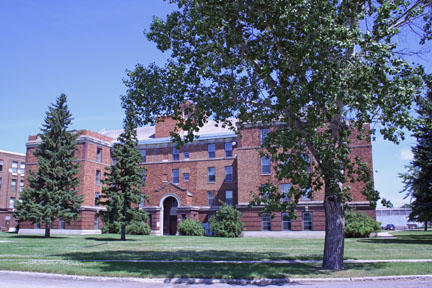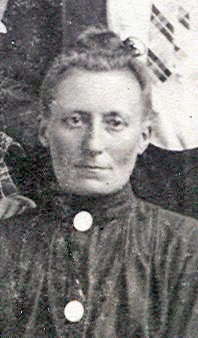
Inger Heline Andersdatter
In April, 1903, Hans left for the United States with his nephew, leaving Inger Helene with the 7 children. Hans traveled to North Dakota (where his brothers Benjamin and Jacob were living) and made preparations for the family. Sons Ludvig and Anton departed Nesna in February, 1904. Inger Helene and daughters Dena and Petra left in August 1904, leaving daughters Kristine (then 22 years old), Marie (20 years old) and Olina (16 years old) behind (although Olina would herself make the journey in 1906).
By the time of the 1910 census the family was settled in Verona, Lamoure County, North Dakota. Hans was working for the Northern Pacific railroad as a Supervisor. Son Anton had just married and was living with his new wife (Marie Dahl) in nearby Logan County. Son Ludvig (then 29) and daughters Olina (21), Dena (15) and Petra (12) were still living at home with their parents, although Ludvig would marry Nora Beatte Anderson in 1911, and Olina would marry William Benjamin Phipps in April, 1914.
What happened next is indisputable: on August 13, 1915 Inger Helene was committed to the State Hospital for the Insane in Jamestown. What may never be fully understood is why it happened, although records and recollections that survive provide some insight and allow one to speculate.
In the “Return of Physician” document filed with the court as part of the commitment proceedings, the physician who examined her in (G.B. Ribble, MD) stated that there had been a previous “attack” 14 months prior (which would have been a few months after Olina’s marriage) manifested by “hypochondria symptoms” for which she was not hospitalized.
He further recorded that the “disease” appeared to be increasing, that there were rational intervals, but that they did not appear at “regular periods”. The “derangement now manifested” in 1915 was “hallucinations and delusions”: she had recently “made two attacks on members of the household with knife”, had threatened to commit suicide with carbonic acid and had a disposition to the destruction of clothing. Leading up to the 1915 incident she had exhibited “religious expressions & temper”. She had “poor physical condition, appetite and slept poor” and had been restrained/confined at home. The family member recorded as giving this information was Mrs. Lena Phipps, Inger Heline’s daughter. Lena also signed the Warrant of Admission document at Jamestown.
Some insight into what might have happened to trigger this event was provided by great granddaughterSharon Smestad [Burke] in August, 2005:
When I was a child, I used to stay with my grandparents on their farm out by Starkweather. Just maybe a week or two at a time. Grandma (Petra) and I would have coffee every afternoon and we would “gossip”. I would talk about my dolls, she would talk about the neighbors… She often mentioned her mother to me. Grandma referred to menopause as “the change” and said how her mom suffered through “the change”.I might tell you that I had heard rumors just the last couple of years that Dena had a child while she was very young, before marriage. When Dena passed away, Grandma Petra stood over her body at the mortuary and said to her, “Dena, your secret is safe with me”. Grandma didn’t know people were listening to her!
One of my aunts, Beverly [Beverly Joan Ness, daughter of Petra], told me that she thought Grandma was talking about Dena’s pregnancy. Well, when I called Uncle Harold [Harold Wayne Ness, son of Petra] yesterday to ask about Dena, he said, “Grandpa [Leonore A Ness] always said that Grandma’s mother was put in the insane asylum because she fell apart when Dena got pregnant. He said the father of the baby was a teacher.
Inger Heline was examined when she was admitted to the hospital: some of the information recorded on the “Physical Characteristics” form was as follows. Her General Nutrition was “Poor”, her tongue was “coated badly”, and was “badly constipated”. She had “Bruises on each arm and on shins when admitted”, and spoke “rambling, broken English”. She was 5 feet 4 inches tall and weighed 123 pounds.
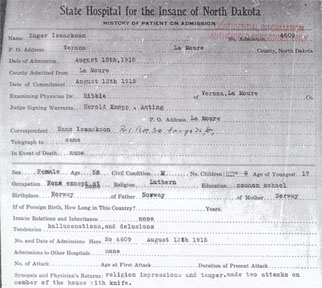
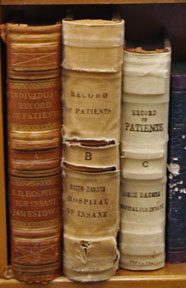
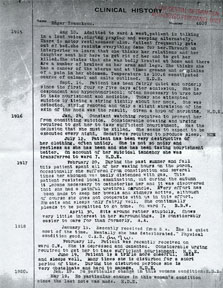
Records from the State Hospital in Jamestown, ND
1915
Aug. 13. Admitted to ward A West. Patient is talking in a loud voice, singing praying and weeping alternately. There is motor restlessness also. Patient frequently gets out of bed. She resists everything done for her. Through an interpreter we learn that she thinks her relations and her daughter sent her here to get rid of her and to get her killed. She states that she was badly treated at home and there are a number of bruises on her arms and legs. She thinks she has a cancer of the uterus and at times groans and complains of pain in her abdomen. Temperature is 100.6 constipated course of calomel and salts outlined. H.D.E.Sept. 16. Patient has been fairly quiet and orderly since the first four or five days after admission. She is despondent and hyperchondriacal; often necessary to urge her to take nourishment and medicine. Today she attempted suicide by tieing a string tightly about her neck. She was detected, string removed and only a slight abrasion of the skin of the neck was the result. Given a hypo of morphine. H.D.E.1916
Jan 24. Constant watching required to prevent her from committing suicide. Considerable coaxing and urging required to get her to take sufficient nourishment. Has the delusion that she must be killed. She seems to expect to be executed every night. Sedatives required to product sleep. H.D.E.July 12. Patient has been very destructive of her clothing, often untidy. She is not so noisy and restless as she has been and she has been taking nourishment better. On account of her suicidal tendency she was transferred to ward 7. H.D.E
1917
February 20. During the past summer and fall this patient spent all of her waking hours on the porch. Occasionally she suffered from constipation and several times her abdomen was badly distended with gas. This patient resisted local examination, but during the autumn is became necessary to catheterize her and it was discovered that she had a painful urethral caruncle. Every effort has been made to keep her bowels and kidneys active, although of course she does not cooperate with us in this effort. She eats and sleeps only fairly well. She continually pleads to be permitted to go home. On ward 7. B.B.W.April 30. Sits around rather stupidly. Shows very little interest in her surroundings. Is considerably easier to care for than formerly. A.A.
1918
January 19. Recently received from 5 W. She is quiet most of the time. Mentally she has deteriorated. Physical condition good. C.A.S.February 12. Patient was recently received on ward C.W. She is depressed and demented. Considerable urging required to get her to take sufficient nourishment. H.D.E.
June 19. Patient is a trifle more cheerful. Eats and sleeps well. Many times she is disturbed for a short period of time. During the disturbed periods she is very obstinate and hard to manage. H.D.E.
1919
July 7th. There is very little change in this woman’s condition. Often she refuses to eat for one or two meals. At times she is very stubborn and opposes everything the nurses attempt to do for her. Health is fairly good. H.D.E.Oct. 31st. Very little change in this woman’s condition. She is quiet, orderly, and seclusive. Now and then she becomes resistive, does not want to get up in the morning or go to bed at night. Quite a bit of urging is required to get her to take nourishment at times. Talks very little. H.D.E.
1920
Jan 20. No particular change in this woman’s condition. H.D.E.Feb. 19. Patient is usually quiet and orderly, thought often very resistive but she gets along fairly well when left to herself. At times she is very stubborn. She does not want to undress at bedtime nor dress in the morning. Occasionally she becomes very badly disturbed and apprehensive fearing that she is going to be injured or killed. She is rather poorly nourished. On C.W. H.D.E.
May 19. No particular change in this woman’s condition since the last note was made. H.D.E.
1921
Jan. 6. She mumbles and cries to herself now and then without apparent cause and spends most of her time standing in a corner of the porch with no desire to associate with other patients. Her physical condition is fair. A.W.O.Mar. 13. Last night she had a bloody expectoration and pain in the right chest. Physical examination today reveals the presence of a cavity at the apex of the right lung. She persists in getting out of bed and wandering about the halls so that it is necessary to place her in a restraint. She complains somewhat of pain in the chest but aside from this she makes few intelligible remarks. A.W.O.
1922
The State Hospital in Jamestown, ND
Jan. 16. Physical condition improved in last six months. Has many delusions. Imagines someone wants to hurt her. All the time runs up and down hall and wants to stay out of doors no matter how cold. Seldom eats with out being forced to first part of meal and after being started usually finishes by herself. Has to be dragged to table. Very hard to manage. A.C.T-CApril 25. Physical condition poor. Very resistive. Has to be fed, put to bed and get up and taken to dining room. Wants to stay out of doors on porch all time, which I permit her to do when the weather is fit. Always seems to think someone wants to hurt her. Very hard to care for. A.C.T-CJuly 19. Condition unchanged. Has to be forced to dining room and forced to eat. She is very resistive. Never associates with the other patients, and never assists with any of the ward work. She talks to herself a great deal, and worries constantly. Temperature is normal and she is gaining weight. A.C.T-C
Dec. 1. Health is very poor. Subnormal. Not in bed. Very resistive. Refuses to eat or do anything. Has many delusions. Very hard patient to care for. A.C.T-C
1923
May 15. Patient shows no mental improvement. She sits in an idle and disinterested manner and does nothing but remain in one position, crying at time and wringing her hands. She shows considerable depression and it is impossible to get her interested in anything. She eats and sleeps very well. Resides on Ward C East. J.D.C.August 6. Patient is a resistive old lady that will not eat without force. Sleeps well. Idle on the ward. Becomes very angry when spoken to and gets along better when left alone. On Ward C West. A.C.T-C
1924
Jan 8th. Patient is a resident of ward 10 west. There is no improvement in the patients mental condition. She is depressed most of the time and sits around idly all day. Physical condition is poor. IDLE AFOC.July 19. This patient doesn’t speak English, but talks to herself all the time. She has to be made to eat, but sleeps well. She goes to O.T. room every afternoon where she does a little work. She is quiet on Ward 10 West. R.A.B.
Oct. 22. This patient sits all day on 10 West. She refuses to talk. She will no do anything without being made to and is very resistive. She eats well when once started. Physical condition is good. RAB
1925
Feb. 2. This patient is idle on 14 West. What little she says is in foreign tongue. She is quiet most of the time. She is very resistive. Physically her condition is fairly good. Her appetite is poor, but she sleeps well. RABApril 21. Patient still resides on 14 West where she does very little except sit all day. She is quite resistive at times. Physically her condition remains the same. RAB
Aug. 28. This patient still resides on 14 West and causes very little trouble. She does not understand questions and at times she mutters to herself. She is quite tidy about herself, but has to be taken to and from the dining room and always shown her chair. Physically her health is not very good. RAB
1926
Apr. 20. This patient resides on ward 14 W. She is idle. She talks to herself continually and raves, often becoming very noisy. She has to be led to the dining room and started to eat. Once started she eats well. Sleep is also good. RABFathers name: Anders Anderson
Born in Norway
Mothers Name: Stina Krestensen
Born in Norway
In U.S. since Sept 14, 1904.Sept. 14. Patient resides on 14 E. She is quiet, untidy and demented, requires much care and supervision and at times is confused and resistive. Health and Phys. con. remains fairly good. JWP1927
June 7. This patient resides on Ward 14 West. The condition of this patient shows no marked change, and if anything is on the downward trend. WHW.Nov. 28. This patient resides on 14 West. This patients’ condition is on the downward trend both mentally and physically. WHW
1928
June 5. This patient is on ward 14 West. She is still very stupid, she has to be led to the dining room and has to be supervised in her eating. She has no insight not oriented, is not clean or tidy. Has no violent or destructive attacks. She eats fairly well and sleeps normally. Mentally there is a gradual deterioration, unfavorable progress. JWM1929
Feb. 22. This patient developed a lung condition and from her rise of temperature in the evening she was transferred to Ward 8 West for observation for Tuberculosis, but findings indicated more of a pneumonia lobar condition. She improved for about tow days then showed no changes and on Feb. 22nd condition was not so good. JWMFeb. 23. Relatives were notified this A.M. as her condition became critical and she finally passed away at 10:45 A.M. JWM
Feb. 25. Body claimed by relatives for burial at her late home. JDC
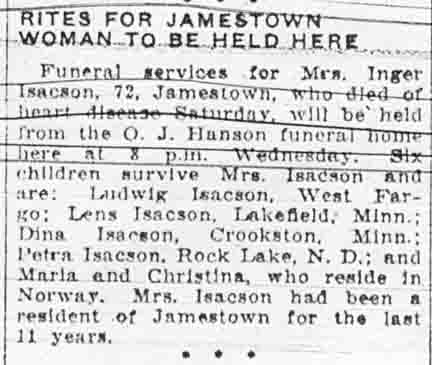
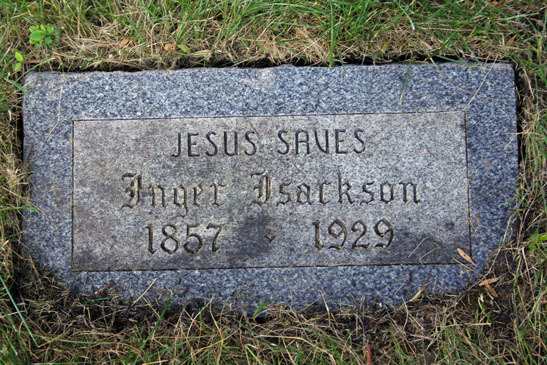
Obituary and Toumbstone for Inger Heline Andersdatter

